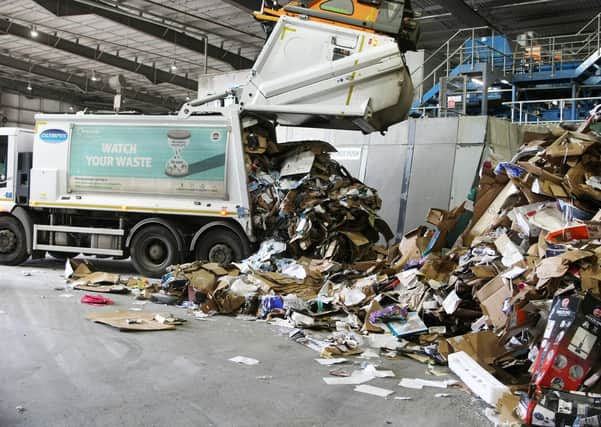West Sussex’s recycling performance a mixed picture


Between 2019/20 and 2020/21, residents in Adur increased the amount of waste which was recycled, reused or composted from 36.6 per cent to 41.5 per cent.
In Crawley it rose from 30.3 per cent to 31.9 per cent, while in Worthing it rose from 40 per cent to 41.5 per cent.
Advertisement
Hide AdAdvertisement
Hide AdHorsham saw a smaller increase, with its recycling rate rising from 53.3 per cent to 53.5 per cent.
Arun (42.3 per cent), Chichester (44.5 per cent) and Mid Sussex (41.7 per cent) saw their rates fall by 0.5 per cent, 0.4 per cent and 1.2 per cent respectively.
For the county as a whole, the rate remained at 53.1 per cent – though the amount of rubbish recycled by the Household Waste Recycling Sites stands at 66.6 per cent.
As part of its Reset Plan between now and 2024/25, the council has set targets requiring a one per cent increase in the countywide recycling rate each year.
Advertisement
Hide AdAdvertisement
Hide AdSome councillors felt the targets were ‘unambitious’ and ‘very modest’, but a council spokesman said they were actually ‘realistic’ and higher than the government’s own target of 55 per cent by 2025.
By 2035, the recycling rate is expected to be 65 per cent.
But to make that increase, regular food waste collections and other new recycling streams will have to be introduced.
The spokesman added: “The county council is now working with West Sussex Waste Partnership partners on the development of new Joint Resources and Waste Strategy for the county which will further encourage coordinated working with district and borough councils to meet these challenges and do so well before 2035.”
Despite its increase, Crawley has by far the lowest recycling rate in the county.
Advertisement
Hide AdAdvertisement
Hide AdA spokesman for the borough council pointed out that the town is much more urbanised than the other areas, having smaller gardens and producing far less garden waste.
As garden waste/composting is part of the recycling figures, Crawley’s efforts take an immediate hit.
But the borough is still developing some glowing green credentials.
The spokesman said: “Crawley took part in a West Sussex Waste Partnership pilot project to set about tackling issues with recycling contamination and participation within flats.
Advertisement
Hide AdAdvertisement
Hide Ad“This project involved a number of aspects including: updating containers, improved signage, working with residents and managing agents, providing leaflets and reusable bags.
“The project proved to be very successful and has since won two national awards.
“Consequently we have continued this work across similar properties within other parts of Crawley and this year are targeting smaller blocks of flats.
“In addition, this year we are also relaunching our small electrical and textiles kerbside collection service, which will include trialling it at flats.
Advertisement
Hide AdAdvertisement
Hide Ad“We are also including battery collections at both individual and flatted households.
“Whilst these materials do not add a huge percentage onto our recycling rate, reducing hazardous waste such as small electricals and batteries from the residual waste stream is very important.”
The spokesman said that the borough council would soon be starting on the re-procurement of its waste and recycling service, aiming to increase recycling rates and reduce its carbon footprint.
He added: “There is talk of a move away from recycling tonnages and percentages to a more carbon-related measure as it is recognised that recycling rates don’t necessarily take account of the full carbon impact.”
Advertisement
Hide AdAdvertisement
Hide AdA spokesman for Mid Sussex District Council said that so many people being home during the pandemic had significantly increased demand on the waste and recycling services.
He added: “As a result, the amount of recycling waste we have collected has gone up, but there has been an even greater increase in the amount of general household rubbish people have created, which means that we have seen a slight drop in our overall percentage.
“We’re determined to do everything we can to support our residents in recycling more and preventing waste.
“The introduction of a food waste service remains a continuing priority and we are committed to the on-going expansion of our recycling services, as demonstrated by the recent introduction of kerbside collections of batteries and small electricals.
Advertisement
Hide AdAdvertisement
Hide Ad“Changes such as these will enable us to address any future changes to national legislation, offer increased value for money and address key environmental concerns.”
A spokesman for West Sussex County Council said 8.8 per cent of waste went to landfill in the year up to April 2021 – a record low for the county.
He added: “We’re committed to ensuring that the vast majority of waste in West Sussex continues to not end up at landfill, and take our environmental responsibilities very seriously.
“Our teams have been working hard to make sure that waste is handled correctly through a range of eco-friendly measures.
Advertisement
Hide AdAdvertisement
Hide Ad“We’ve been able to divert our residual waste from landfill and convert it into a product called Refuse Derived Fuel. Turning non-recyclable waste into fuel has many benefits such as reducing the need for landfill and the reliance on fossil fuels for energy and makes strong environmental and economic sense.”
This article previously contained incorrect figures on how much recycling goes to landfill, which have now been updated.